When you are now thinking about which lenses you should choose. Stay with me because we will break down exactly the pros & cons of progressives and bifocals for you.
In most cases, progressives are a better choice. Because they provide a continuous clear vision from far to near and in between. Although you need to plan in a little more time to get used to them due to the blurry sides. Progressives also look better because of the missing line. And if you need a strong reading zone they will not have a blurry gap in front of you. But you will learn in the article when each of them would work better.
Which One Has the Bigger Reading Zone Progressives or Bifocal Lenses
Usually, bifocals have a bigger reading segment. However, this depends on what kind of segment you choose in your bifocal lenses. There is a variety of them. You can choose between different shapes of the reading segment and different sizes. The standard bifocals come with a shape that has a flat or slightly rounded top and has a semicircle shape in the bottom. The size of it varies between 25-28mm which gives you as a wearer the ability to perform really big eye movements as you read your newspaper.

But bifocals just provide you with only one sharp distance. Compared to bifocals, progressive lenses have a smaller reading zone that gives lets you see two to three articles clearly in your newspaper depending on your prescription. But progressive lenses enable you to have every distance sharp between the distance vision and the near range which bifocals do not. In progressive lenses, you can not really choose the size of the reading zone but you can stretch the transition into the reading zone a bit more to get more out of the middle distance.
On the one hand, really short progressive glasses will have a smaller zone for the middle distance like your laptop and you do not have to look down as much while reading. On the other hand, you get really long progressive lenses to force perform bigger eye movements down to be able to read. But therefore you get a slightly bigger reading zone.

As we described the progressive lenses change the size of the reading zones depending on what lens, length in the lens you choose in combination with your reading power. In bifocals, you will not have to see how the result will affect your reading. If you order a lens segment with a width of 28mm you will get a reading segment of the ordered size and shape.
Surfaces of Progressives Lenses and Bifocals
When you want a bigger reading segment in bifocals you get a more dominant line because the surface will be more heeled. As you can see below in this heeled area dirt can accumulate over time.
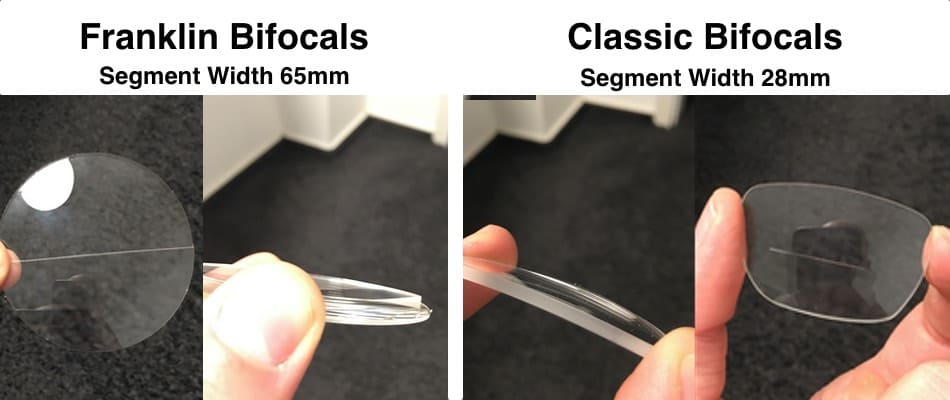
Also in addition to the increased visibility of someone that is looking at you, the line is also more or less dominant depending on the lighting around you. The reason is that the heeled part of the lens surface is not as coated with an AR as the rest of the lens. Most of the bifocals on the market have this visible line and progressives do not. They have no heeled part of the surface. It,s just all smooth.
To be fair there are no-line bifocals that also have a smooth surface without a heeled part. Those lenses are oftentimes described as freeform bifocals. In these newer bifocals, you can have really big reading zones and no line gets added.
side note from me
The difference to normal progressives is when you perform eye movements from the upper lens segment for distance vision down to the reading segment you are directly in your prescription and everything is clear. In freeform bifocals, you get a small transition zone instead of a line that produces a blur. As you look down further with your eyes you will get into the big reading segment.
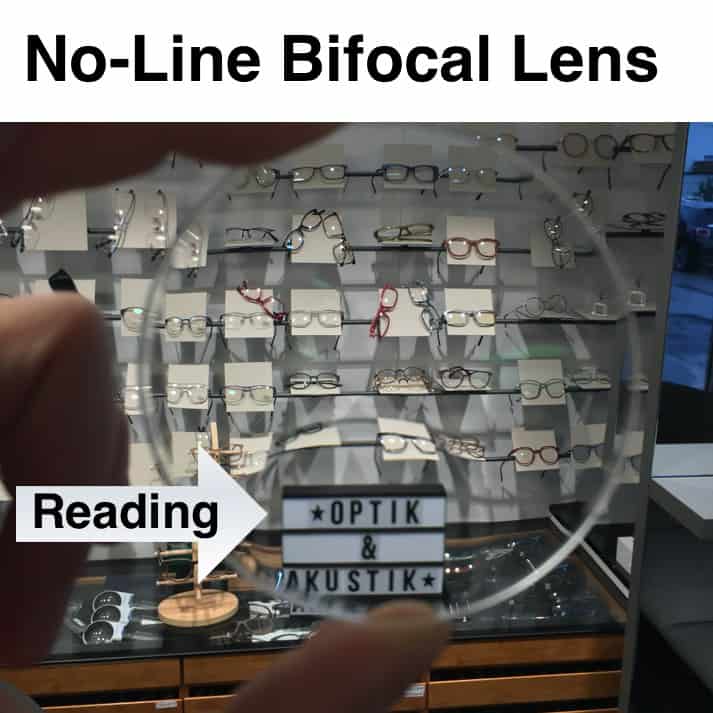
The Cost of Progressives vs. Bifocals
Usually, bifocals will be cheaper than progressives. The prices for a pair of progressive lenses start at 175 – 250¢ and can go up to over 600$ depending on what you choose. Compared to that the prices for bifocals start at 100$ but can go up to 800$ and more if you add special segment shapes for the reading zone.
If you want to order progressives or bifocals there is a huge variety of options. And sure you can just get the standard reading zones and get away with lower-priced lenses that also can be fine for you. But if you compare segment shapes you might find something which is actually better for you. Think about the situation when somebody does not want to change glasses as he walks the stairs. Fo him it would be good to make the reading zone smaller so he can see the stairs clear again.
Because he is looking underneath the reading segment which again holds the distance vision part. Depending on the lenses this could lead to an enormous difference in the price. You could even combine progressives and bifocals if you wish to read something above your head. But of course, those more specialized solutions are more costly.
The Adaption of Progressive Glasses vs. Bifocals
You get pretty fast used to your bifocals. You can immediately see where there are clear zones for you to look through and the fields of view are extremely wide. That can take on to two weeks but usually, people get in a short time frame. When you compare wearers of progressive lenses to that they have oftentimes a harder time in the beginning which can take them one or two weeks more to get used to the new glasses.
The reason is they are not used to pointing their nose in a direction they want to look at. They just perform eye movements into the blurry part of the lenses that aren’t as easy to spot as in bifocals. You just realize it when you are looking through the blurry zones. After this time of adaption has passed wearers of progressive lenses won´t miss their glasses.
If time passes and you start using progressive lenses later in life (in your 50s and 60s) your time for adaption will be longer. The reason, therefore, is the higher prescription needed for your reading zone compared to when you were in your 40s. This leads to more distortions. As you can see down below we made a graphic that illustrates the fields of view of a progressive and a bifocal lens in your 40s.
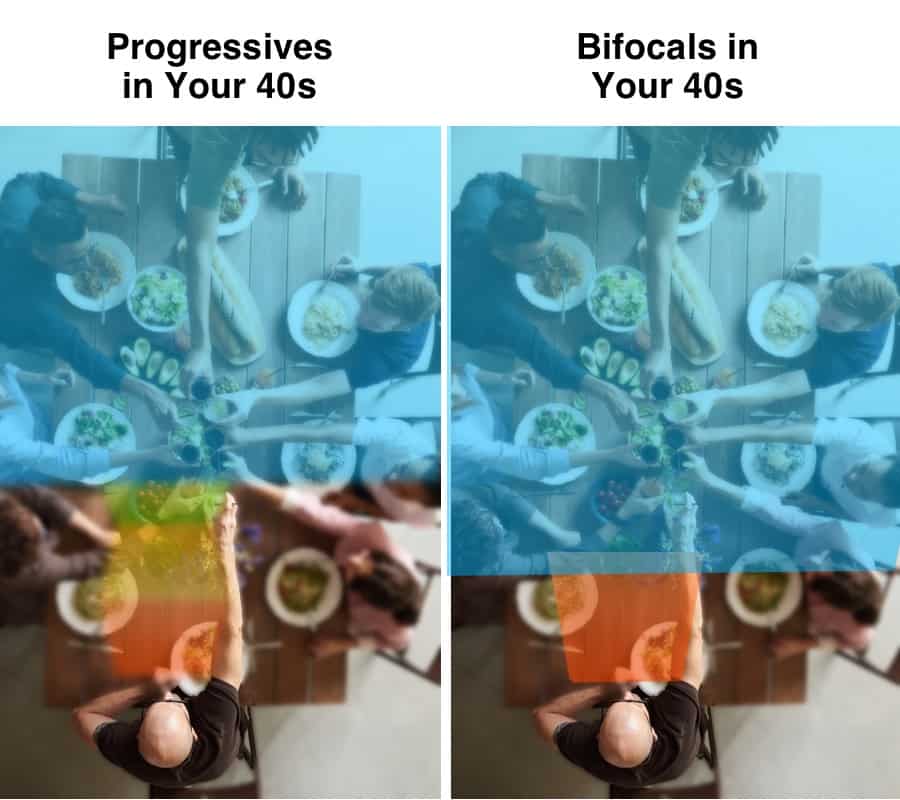
Have a close look at the red and blue field on the right side of the picture. Notice the overlap in the red and blue zones. Here you can see clearly whether you are using the upper or the lower part of the lens. This is due to the low reading power needed and your eyes that can still accommodate the near range. In the next 10 to 15 years and this will change as your eyes lose the ability to accommodate the near range. This leads to stronger reading zones in your lenses and the overlap will disappear.
When this happens you will be usually in your mid-50s. Your lenses got stronger over time and at this age, the process stops because your lenses in your eyes pretty much lost all the ability to accommodate to the near range. So your reading segments will not get as stronger as +2,00D to 2,50D in addition to your distance prescription. What happens now in your new glasses is you will have vastly other experiences with your bifocals and your progressives. But see for yourself in the picture down below.
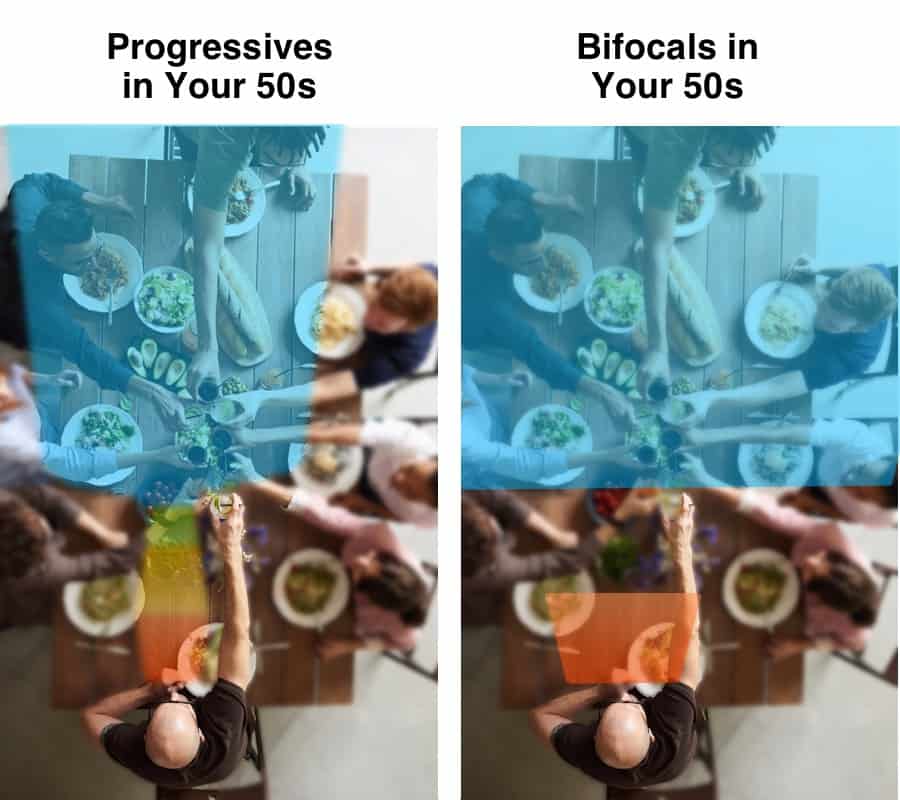
If you compare both pictures you recognize both lenses have drawbacks. But the technology of the progressive lenses accomplished a bigger market share because of them all in one possibility you get. Think about a laptop and a wearer with stronger bifocals. He has to approach the screen more as his natural posture would be to be able to see it clearly. That is nerve-wracking.
You could still add a segment to get rid of the blurry gap but then you will end up with two lines. For some, that´s the solution for most not. Besides the gap, I mentioned progressives look better. (Apart from that no-line bifocal lens design)

As you can see in the picture above there is no option that fits all people’s solutions with progressive lenses. In the left part of the image, you see a lower-priced progressive lens with standard parameters. On the right, you can see a customized progressive lens with an individual set of parameters. The difference can be as big as the illustration but it does not have to be as big.
In bifocals, you do not have to choose these options because individual parameters are not as relevant to your experience with the lenses as they are with progressive lenses. So the experience from person to person varies more with progressive as it does with bifocals.
Why Does the Image Jump When You Switch From Far to Near?
The reason behind this is prismatic powers in your lenses that change when you perform eye movements. In fact the more you look out of the center of the lens the more those powers arise. These effects are found in most bifocal lens designs and are dependent on the shape of your reading segment and your reading power. There are very few view lenses on the market you can order without an image jump. In most cases, you just get used to it.
In progressive lenses, you will not have this kind of image jump. But some people also report a jumping image as they look up or down in the lens. This is also usually due to prismatic powers that change as you alter the spot you are looking through. If your left and right eye have very different prescriptions you might run into this problem. In such a case it would be wise to go for a shorter progressive lens design to fight this effect or get a special cut on the lens surface which is called “slab off”.
Straight Lines Appear Bent Bifocals vs. Progressive Lenses
This effect is most common in progressive lenses. The stronger they get the more likely it is to happen. For most people, this is very irritating when they sit on a desk or want to walk stairs. Over time you get used to it and you will not notice the bent lines anymore. In rare cases, people will also report similar effects if their prescription is higher +/- 6D with their bifocals. But it is not so common as with progressives.
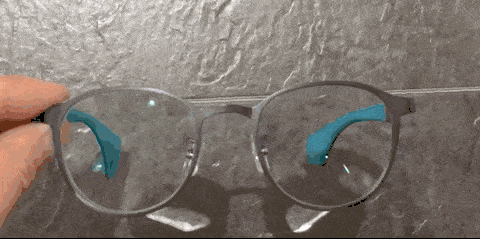
Your Options May Be a Little Limited in Bifocals Compared to Progressive Lenses
As you already saw in the text above there is a huge variety in bifocal lenses. But depending on the reading segment you wish to have in combination with a special tint you might not be able to get it. The options you get when ordering your lenses is just bigger with your progressive lenses. However, manufacturers have indeed different possibilities.
If you do not get what you want immediately I bet your optician will be motivated to call a few labs more to get you exactly what you want. Maybe you are lucky and it is available elsewhere.
How Do They Look in Your Face? Progressives vs. Bifocals
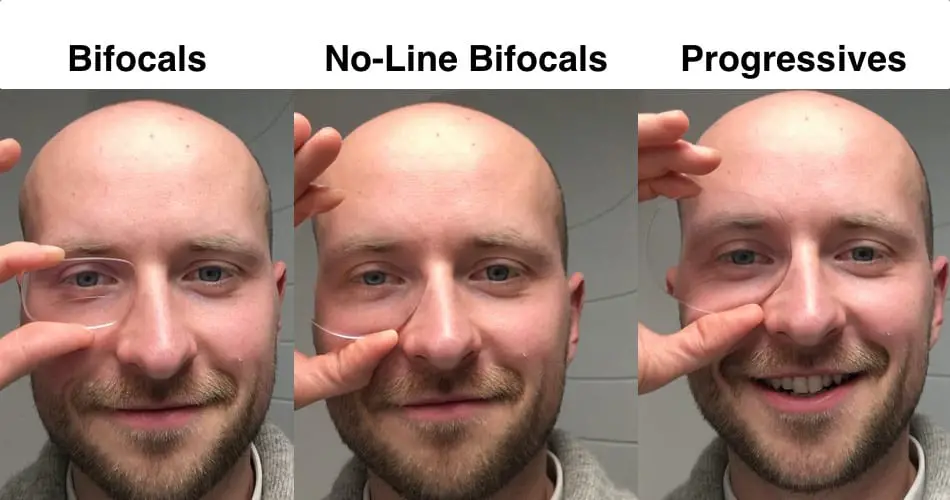
Here in the picture above you can see the differences. On both pictures on the right, you can not find any line because there is any. The picture on the left shows a marginal line that comes from bifocals with an Addition of +1,75. You will notice it more as the light hits the lens’s surface from another angle. And you would notice the line more as I would not that pale as I am right now.

